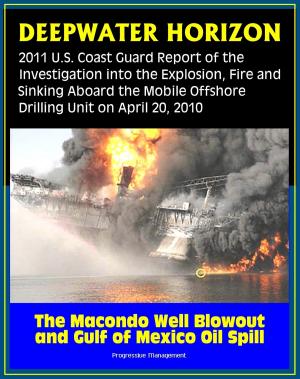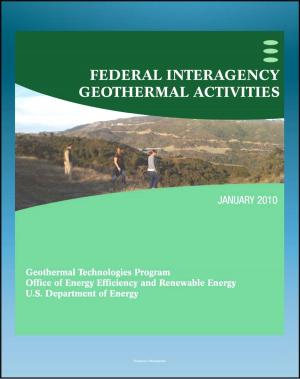2012 Guide to Natural Gas Hydraulic Fracturing from Shale Formations: Improving the Safety and Performance of Hydraulic Fracturing and Fracking
Nonfiction, Science & Nature, Science, Earth Sciences, Geology, Biological Sciences, Ecology| Author: | Progressive Management | ISBN: | 9781465905604 |
| Publisher: | Progressive Management | Publication: | October 4, 2011 |
| Imprint: | Smashwords Edition | Language: | English |
| Author: | Progressive Management |
| ISBN: | 9781465905604 |
| Publisher: | Progressive Management |
| Publication: | October 4, 2011 |
| Imprint: | Smashwords Edition |
| Language: | English |
The important controversy over hydraulic fracturing for shale gas production is covered in detail in this ebook, with a collection of up-to-date official documents and publications on the risks and rewards of shale gas. New material includes the work of the Secretary of Energy Advisory Board Natural Gas Subcommittee striving to improve the safety and environmental performance of fracturing; EPA plans to study the potential impact of fracturing on drinking water resources; USGS material on Marcellus shale gas development and water resource issues; National Energy Technology Laboratory Comparative Study of the Mississippian Barnett Shale, Fort Worth Basin, and Devonian Marcellus Shale, Appalachian Basin, and more. Contents include material from the EPA, USGS, Department of Energy, the Energy Information Administration (EIA) and others.
Section 1: Natural Gas Subcommittee of the Secretary of Energy Advisory Board - Safety of Shale Gas Development * Section 2: Blueprint for a Secure Energy Future * Section 3: Secretary of Energy Advisory Board - Shale Gas Production Subcommittee 90-Day Report * August 18, 2011 * Section 4: Draft Plan to Study the Potential Impacts of Hydraulic Fracturing on Drinking Water Resources * U.S. Environmental Protection Agency Office of Research and Development * June 28, 2011 * Section 5: Marcellus Shale-Gas Development and Water-Resource Issues * New York Water Science Center * John Williams * USGS * Section 6: Shale Gas Presentation to the SEAB Natural Gas Subcommittee * Section 7: Natural Gas Hydraulic Fracturing * Issues USGS is Tracking * Section 8: EPA Briefing to the SEAB Natural Gas Subcommittee to Examine Fracking Issues * Section 9: Shale Gas: Applying Technology to Solve America's Energy Challenges * Section 10: DOE/NETL-2011/1478 * A Comparative Study of the Mississippian Barnett Shale, Fort Worth Basin, and Devonian Marcellus Shale, Appalachian Basin * Section 11: Energy in Brief — What everyone should know about energy
The DOE Advisory Board report states:
The development of shale gas in the United States has been very rapid. Natural gas from all sources is one of America's major fuels, providing about 25 percent of total U.S. energy. Shale gas, in turn, was less than two percent of total U.S. natural gas production in 2001. Today, it is approaching 30 percent. But it was only around 2008 that the significance of shale gas began to be widely recognized. Since then, output has increased four-fold. It has brought new regions into the supply mix. Output from the Haynesville shale, mostly in Louisiana, for example, was negligible in 2008; today, the Haynesville shale alone produces eight percent of total U.S. natural gas output. According to the U.S. Energy Information Administration (EIA), the rapid expansion of shale gas production is expected to continue in the future. The EIA projects shale gas to be 46 percent of domestic production by 2035.
Four major areas of concern are: (1) Possible pollution of drinking water from methane and chemicals used in fracturing fluids; (2) Air pollution; (3) Community disruption during shale gas production; and (4) Cumulative adverse impacts that intensive shale production can have on communities and ecosystems. There are serious environmental impacts underlying these concerns and these adverse environmental impacts need to be prevented, reduced and, where possible, eliminated as soon as possible. Absent effective control, public opposition will grow, thus putting continued production at risk. Moreover, with anticipated increase in U.S. hydraulically fractured wells, if effective environmental action is not taken today, the potential environmental consequences will grow to a point that the country will be faced a more serious problem. Effective action requires both strong regulation and a shale gas industry in which all participating companies are committed to continuous improvement.
The important controversy over hydraulic fracturing for shale gas production is covered in detail in this ebook, with a collection of up-to-date official documents and publications on the risks and rewards of shale gas. New material includes the work of the Secretary of Energy Advisory Board Natural Gas Subcommittee striving to improve the safety and environmental performance of fracturing; EPA plans to study the potential impact of fracturing on drinking water resources; USGS material on Marcellus shale gas development and water resource issues; National Energy Technology Laboratory Comparative Study of the Mississippian Barnett Shale, Fort Worth Basin, and Devonian Marcellus Shale, Appalachian Basin, and more. Contents include material from the EPA, USGS, Department of Energy, the Energy Information Administration (EIA) and others.
Section 1: Natural Gas Subcommittee of the Secretary of Energy Advisory Board - Safety of Shale Gas Development * Section 2: Blueprint for a Secure Energy Future * Section 3: Secretary of Energy Advisory Board - Shale Gas Production Subcommittee 90-Day Report * August 18, 2011 * Section 4: Draft Plan to Study the Potential Impacts of Hydraulic Fracturing on Drinking Water Resources * U.S. Environmental Protection Agency Office of Research and Development * June 28, 2011 * Section 5: Marcellus Shale-Gas Development and Water-Resource Issues * New York Water Science Center * John Williams * USGS * Section 6: Shale Gas Presentation to the SEAB Natural Gas Subcommittee * Section 7: Natural Gas Hydraulic Fracturing * Issues USGS is Tracking * Section 8: EPA Briefing to the SEAB Natural Gas Subcommittee to Examine Fracking Issues * Section 9: Shale Gas: Applying Technology to Solve America's Energy Challenges * Section 10: DOE/NETL-2011/1478 * A Comparative Study of the Mississippian Barnett Shale, Fort Worth Basin, and Devonian Marcellus Shale, Appalachian Basin * Section 11: Energy in Brief — What everyone should know about energy
The DOE Advisory Board report states:
The development of shale gas in the United States has been very rapid. Natural gas from all sources is one of America's major fuels, providing about 25 percent of total U.S. energy. Shale gas, in turn, was less than two percent of total U.S. natural gas production in 2001. Today, it is approaching 30 percent. But it was only around 2008 that the significance of shale gas began to be widely recognized. Since then, output has increased four-fold. It has brought new regions into the supply mix. Output from the Haynesville shale, mostly in Louisiana, for example, was negligible in 2008; today, the Haynesville shale alone produces eight percent of total U.S. natural gas output. According to the U.S. Energy Information Administration (EIA), the rapid expansion of shale gas production is expected to continue in the future. The EIA projects shale gas to be 46 percent of domestic production by 2035.
Four major areas of concern are: (1) Possible pollution of drinking water from methane and chemicals used in fracturing fluids; (2) Air pollution; (3) Community disruption during shale gas production; and (4) Cumulative adverse impacts that intensive shale production can have on communities and ecosystems. There are serious environmental impacts underlying these concerns and these adverse environmental impacts need to be prevented, reduced and, where possible, eliminated as soon as possible. Absent effective control, public opposition will grow, thus putting continued production at risk. Moreover, with anticipated increase in U.S. hydraulically fractured wells, if effective environmental action is not taken today, the potential environmental consequences will grow to a point that the country will be faced a more serious problem. Effective action requires both strong regulation and a shale gas industry in which all participating companies are committed to continuous improvement.















